All Aflutter | Beckon Butterflies to Your Grand Garden Resort
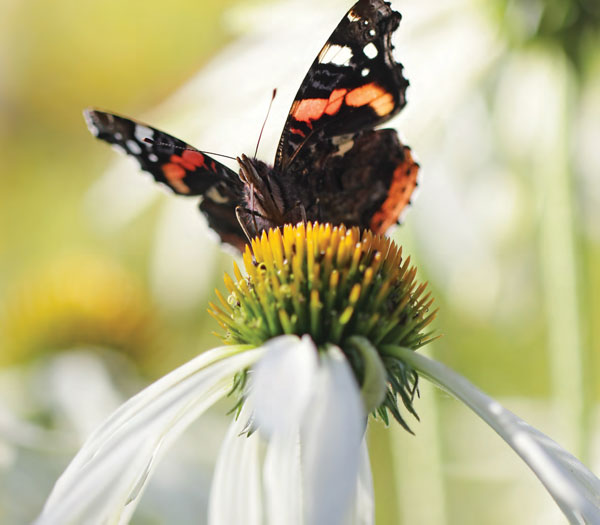
There are plenty of insects that aren’t welcome in our yards, and we certainly spend enough time and money to make sure they don’t intrude and ruin all of our hard work. But some special guests are invited back year after year—friendly butterflies. Who doesn’t enjoy their dainty dance around blooms as they show off their colorful couture? When it comes to welcoming these fragile beauties, the more, the merrier. Learn how you can be the best hostess to these garden VIPS.
interesting fact
WHEN BUTTERFLIES FIRST EMERGE, THE MALES AND FEMALES HAVE DIFFERENT GOALS: THE MALES TEND TO FLY STRAIGHT TO FLOWERS FOR THEIR FIRST MEAL AND THE FEMALES WILL MATE BEFORE EATING.
(National Audubon Society)
The jury is still out on how the butterfly got its name. It could be because the insect was often seen flying around the butter churn, or perhaps because anywhere it goes it “flutters by,” and people combined the syllables to form “butterfly.” Regardless of how the butterfly got its name, scientists have been researching the 20,000 species of the insect for many years. According to the National Audubon Society, there are 700 species of butterflies in North America. In Virginia, there are several species which will make reservations here if they find conditions to their liking. To help you attract butterfly visitors and keep them on as more permanent guests throughout their life cycle, we’ve compiled a few guidelines for happy hosting.
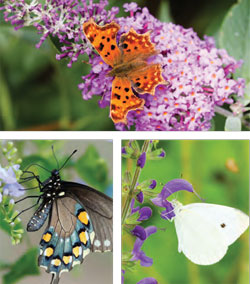
Fancy feasters
Picky, picky, picky: No, I’m not talking about your kids at dinnertime. It’s a fact that many species of butterfly, including their former caterpillar selves, are particular in their choice of meals.
There’s no one-size-fits-all foodplant or nectar flower that will fully satisfy all butterfly varieties. We have learned that simply planting the popular butterfly bush (buddleia) isn’t guaranteed to attract more butterflies.
However, for the best butterfly habitat, you need to provide two basic plant types that cater to the needs of each part of the butterfly’s life cycle. The adult butterfly needs “host plants,” ideally plants that are safe for them to both mate and lay eggs upon, and will also provide plenty of food once the eggs hatch into hungry caterpillars. The creatures’ main eating period takes place in the larval stage, when the rapidly growing caterpillars eat non-stop to store up the energy they need to molt over and over—up to five times—to enter their pupal stage and complete the grand finale of metamorphosis.
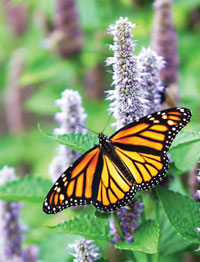
Once metamorphosis is achieved, the newly emerged butterflies require “nectar plants”—an attractive mixture of brightly colored, flowering plants that will provide plenty of sweet nourishment. Butterflies crave high-sugar nutrition to prepare for flight and store up energy for migration. Planting host plants and nectar plants near each other will ensure more butterflies in your garden. Because butterflies are also pollinators, many of the plants that attract hummingbirds and bees are great for butterflies, too.
Garden enthusiasts work hard to provide the plants that cater to specific butterflies throughout their life cycles. The North American Butterfly Association has a chart of plants specifically for Central Virginia at nababutterfly.com/regional-butterfly-garden-guides. It lists the top butterfly nectar plants and leafy caterpillar plants, along with the corresponding butterfly species for each. For example, a good caterpillar foodplant for the Eastern Tiger Swallowtail—the official state insect of Virginia—is the tulip tree; some of the best nectar options for the butterfly stage are lantana, zinnia, azaleas, Asiatic lilies, and thistles.
Some butterflies are so picky that they only choose specific plants. The Great Spangled Fritillary, for instance, will lay her eggs under bushes near violets that have died off for the season, because her caterpillars only feed on violets.
The NABA chart is a great place to start when planning out a lasting butterfly habitat; it tells you how long the flight periods are for many of our regional butterflies—some fly from spring to fall. For this reason, choose a variety of nectar plants that will keep your garden blooming through each season. Like hummingbirds, butterflies enjoy brightly colored flowers, so make sure to roll out the red carpet for these special guests.
The chart also lists more unusual types of butterflies to be found in Central Virginia and their larval plants of choice—Sachem (crabgrass), Tawny Emperor (hackberries), and Whirlabout (grasses). The Virginia Cooperative Extension also provides a planting guide for host plants in our region (visit ext. vt.edu).
Butterflies generally like a sunny stage to show off their finery, so choose plants that will do best in full sun; the sun actually warms up the butterflies’ wing muscles so they can fly. Also, plant their favorites in clumps together so more can dine at the same table.
The greater the variety of host and nectar plants you offer, the wider variety of butterflies you can expect to see.
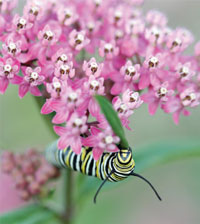
Safe keeping
Some butterflies are also attracted to plants that will help protect them from predators, even in the larval stage. Of all insects, caterpillars are the tastiest items on the garden menu for other animals—birds especially—so protection is important. One of the ways butterflies can make themselves less attractive to prey is to feed on toxic plants. Monarch caterpillars feed on milkweed, for example, and store the toxin in their bodies, making themselves poisonous to predators or at least distasteful—after the first bite, those birds won’t be coming back for more. (Milkweed is also the only plant that Monarchs lay eggs on, so it is a sure bet for your garden.)
You’ll also find splendid camouflage tactics among butterflies: one common visitor to local gardens and parks is the Question Mark butterfly. This species may look like a dead leaf when its wings are folded—with a tiny white mark resembling a question mark—but when it opens its wings, you’re in for a nice surprise.
Maid service, please
Butterflies prefer a tidy garden. Prolong the blooming season by deadheading flowers, watering well, and mulching with organic compost. Caterpilars and butterflies are sensitive to pesticides and insecticides, so keep those at bay.
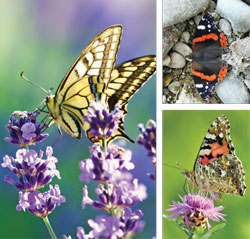
Spa time
Another way to cater to guests fluttering by is to create a sunny basking area, with flat rocks and small water “puddling” areas. Male butterflies, especially, like to absorb minerals in the soil that can be used for reproduction; they use their long proboscis as a straw to sip water from mud puddles. The Virginia Cooperative Extension’s publication Creating Inviting Habitats suggests making a puddling area by placing a shallow dish at ground level and filling it with sand mixed with soil from your yard. By keeping it damp, you may see butterflies flock to this favorite spot.
With their famous tale of metamorphosis—one of the most amazing in the insect world—and with their vivid, winged wardrobes that the world’s top fashion designers cannot begin to pattern, butterflies deserve the grandest surroundings for their flamboyant flights in your garden. Cater to their refined tastes and your yard will become the Ritz-Carlton of the butterfly kingdom. ✦
butterflies, Butterfly bush, camouflage, Central Virginia, garden, Great Spangled Fritillary, host plants, larval stage, leafy caterpillar plants, metamorphosis, nectar plants, North American Butterfly Association chart







Geraldine N.
I read your post on attracting butterflies to your garden and I have to say I agree with you! Butterflies are beautiful creatures and it’s great that more people are interested in attracting them to their gardens.